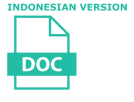Fenomena Penggunaan Dialek Gyeongsang-do (경상도 방언) dalam Drama Korea ‘Reply 1994 (응답하라 1994)’
Jose Leandro(1), Keren Prasetyanti(2), Amanda Pniel(3), Asma Azizah(4*), Velayeti Nurfitriana Ansas(5)
(1) Universitas Pendidikan Indonesia
(2) Universitas Pendidikan Indonesia
(3) Universitas Pendidikan Indonesia
(4) Universitas Pendidikan Indonesia
(5) Universitas Pendidikan Indonesia
(*) Corresponding Author
Abstract
This study focuses on discussing the use of the Gyeongsang-do dialect found in the Korean drama 'Reply 1994 (응답하라 1994)'. The purpose of this study was to determine the most used dialect by the characters in the drama. This research was conducted because many foreign viewers from outside Korea find it hard to understand the use of Korean dialects due to the various types. By doing this research, hopefully, that Korean drama viewers who come from outside Korea would know and understand the use of dialect used in the drama. The method used in this research is descriptive qualitative with the use of listening and note-taking techniques. In this study, the dialects found in the Korean drama 'Reply 1994 (응답하라 1994)' were analyzed and then classified based on the grammar and vocabulary used in the Gyeongsang-do dialect. The results of this study indicate that in the Korean drama 'Reply 1994 (응답하라 1994)', from 354 speeches containing the Gyeongsang-do dialect, there are 210 speeches in the grammatical category and 246 speeches in the vocabulary category.
Keywords
Full Text:
PDFReferences
Anas, H. (2018). Analisis Wakamono Kotoba pada Media Sosial Twitter [Skripsi, Universitas Muhammadiyah Yogyakarta http://repository.umy.ac.id/123456789/20741
Chaer, A. (2003). Linguistik Umum. Rinekta Cipta.
Choi, M. U. (1998). Classification of Korean’s dialect. Saegukeo saenghwal. 8. 5-29.
Deriananda, N. S. (2019). Analisis Saturi pada Lagu BTS: ‘Paldogangsan (팔도강산) [Tugas Akhir, Universitas Nasional]. http://repository.unas.ac.id/id/eprint/1824
Effendi, M. S. (2012). Linguistik sebagai ilmu bahasa. Jurnal Perspektif Pendidikan, 5(1), 97-101. https://www.ojs.stkippgri-lubuklinggau.ac.id/index.php/JPP/article/view/353
Malabar, S. (2015). Buku sosiolinguistik. Ideas Publishing.
Muhassin, M. (2014). Telaah Linguistik Interdisipliner dalam Makrolinguistik. English Education: Jurnal Tadris Bahasa Inggris, 6(1), 1-21. http://dx.doi.org/10.24042/ee-jtbi.v6i1.516
Namuwiki (2023). 가가가가. Diakses pada 10 Oktober 2023. https://namu.wiki/w/%EA%B0%80%EA%B0%80%20%EA%B0%80%EA%B0%80
Paramitha, N. P. (2017). Implementasi Pendekatan Sosiolinguistik dalam Pembelajaran Bahasa Arab. Jurnal Komunikasi dan Pendidikan Islam, 6(2), 163-191. https://journal.staimsyk.ac.id/index.php/almanar/article/view/75
Purwantoro, W. (2012). Istilah-Istilah dalam Register Fotografi Digital pada Majalah Digital Camera. [Skripsi, Universitas Negeri Yogyakarta] http://eprints.uny.ac.id/id/eprint/9873
Sari, R. (2012). Penggunaan Register Pengunduh Sarang Burung Lawet di Goa Karang Bolong Kabupaten Kebumen. [Skripsi, Universitas Negeri Yogyakarta] http://eprints.uny.ac.id/id/eprint/8429
Subandi. (2011). Deskripsi Kualitatif Sebagai Satu Metode dalam Penelitian Pertunjukan. Harmonia, 11(2), 173-179. https://doi.org/10.15294/harmonia.v11i2.2210
Suwardini, A. (2018). Perbedaan Dialek Gyeongsang dan Dialek Seoul [Tugas Akhir, Universitas Nasional] http://repository.unas.ac.id/id/eprint/1935
Article Metrics
Refbacks
- There are currently no refbacks.
Copyright (c) 2023 The Author(s)

This work is licensed under a Creative Commons Attribution-ShareAlike 4.0 International License.








